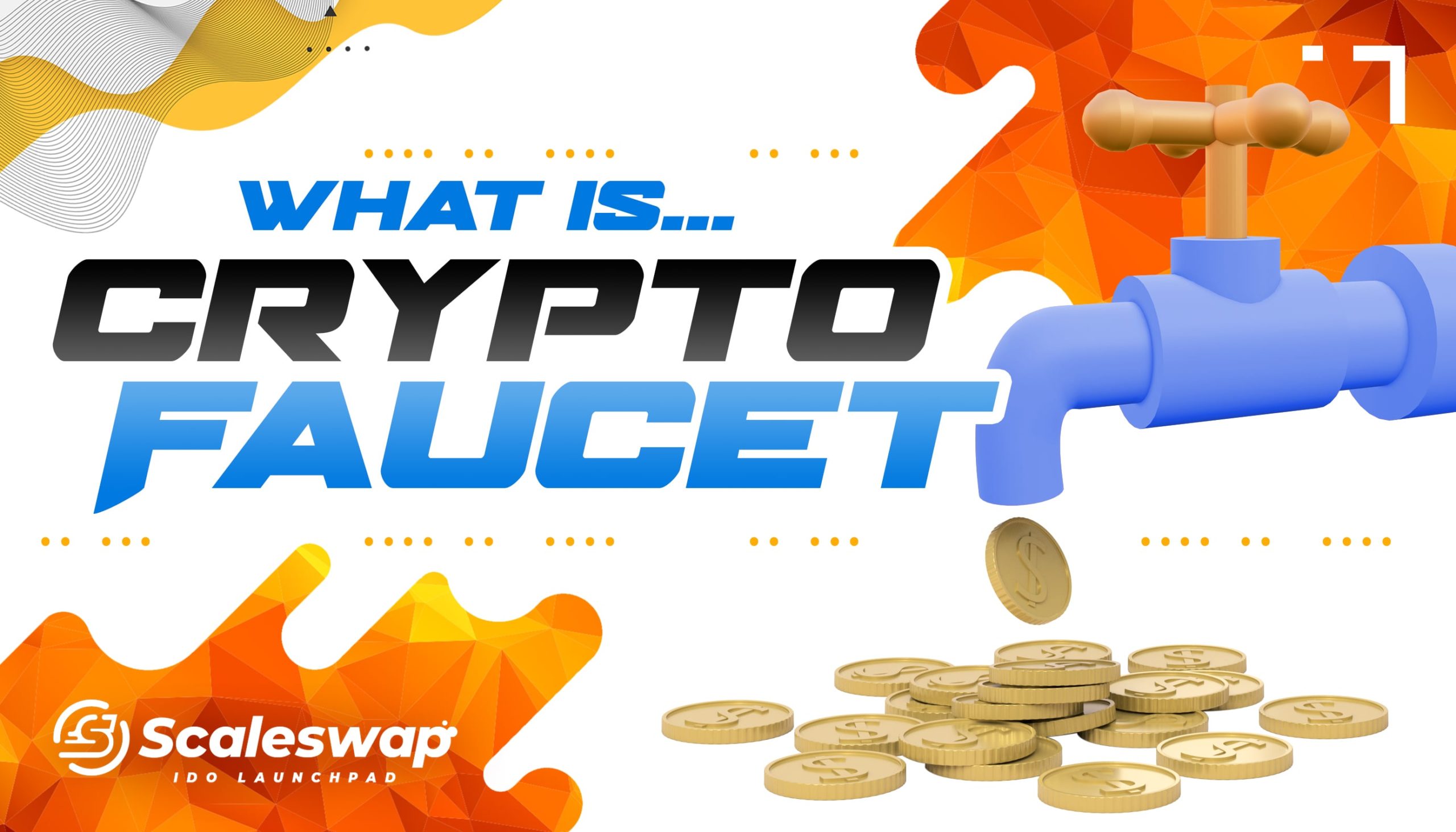Cryptocurrency is a massive space with new technologies and things to learn, and airdrops are no different. You may have heard the phrase “crypto airdrop” or “token airdrop” in some capacity or form, but you might not fully understand what it means. Like anything in the crypto space, it’s important for everyone to understand what they are getting involved with. Fortunately, this guide will give you a comprehensive look at crypto airdrops.
Let’s take a look at what airdrops are, why they are used, how they work, the different types of airdrops, and how you can remain safe when interacting with them. We can also see how ScaleSwap has developed its own ScaleSCORE system, which includes a weighted mechanism that makes airdrops fairer and more distributed among deserving users.
What Are Crypto Airdrops?
In the cryptocurrency world, an airdrop is a marketing tactic where a company or organization distributes a freebie of tokens or coins to the wallets of users. Airdrops are usually distributed by new projects that are looking to create a community and raise awareness about their project.
Some airdrops require users to perform certain tasks, such as following a Twitter account or sharing a post on social media. Others are simply given to anyone who holds a specific cryptocurrency. For example, holders of Bitcoin or Ethereum may be eligible for airdrops of new tokens that are built on top of those blockchain platforms. In most cases, airdrops are attractive to the average user because they have a value attached to them or a future increase in value. This can be subjective however and this doesn’t mean they will have value in the future. In fact, some airdrops may not have value by the time they are received by someone.
Crypto airdrops can be a great way to earn free cryptocurrency. However, it’s important to do your research before claiming an airdrop. Scammers have been known to create fake airdrops in order to steal people’s private keys or personal information. Only claim airdrops from trusted sources and beware of any red flags, such as a lack of information about the project or unrealistic promises.
How Do Crypto Airdrops Work?
Airdrops among crypto projects are relatively common but how do they work exactly? Airdrops usually happen when a new digital asset is launched. The project team will often distribute the new asset to a large number of wallet addresses to promote the project. Airdrops can also happen when a blockchain project forks (splits into two separate projects). In this case, the team behind the new project will often airdrop the new asset to holders of the original asset.
In this way, airdrops usually occur as part of a project’s needs and have good reasons why they distribute their tokens, often for free or in exchange for something.
Five Reasons Why Crypto Projects Do Airdrops
Airdrops are a fairly common practice among projects in some shape or form. Some projects distribute airdrops without any sort of requirement and sometimes without a vetting process. Others require a whitelist of sorts, either by a set of visible rules or by using a project pre-tokenized where users qualify for automatic airdrops because of their involvement or activity. Despite the method, there are five reasons why projects will do airdrops.
There are many reasons why crypto projects will distribute airdrops, each with its own distinct advantages and aspects for doing so:
- Awareness: Airdrops help crypto projects to increase awareness and engagement. This is one of the easier ways to get direct engagement with a token for a project by offering airdrops, usually, one of the top reasons projects will distribute tokens
- Live Testing: Airdrops can help to attract new users and encourage them to try out a project. In many ways, projects want to have a live audience that is not sandboxed into a beta release, Airdrops are a great way to get real users to use a project in the wild.
- Marketing: Airdrops can also be used as a marketing tool to promote a project or product. This is one of the most effective ways to get people to discuss tokens directly, share them with friends, and see what they can do with the tokens given to them.
- Community: Airdrops can help to build a community around a project. When enough tokens are given out, sometimes this can lead to a passionate grassroots community that adds an organic level of interaction with the protocol.
- Alternative Distribution: Airdrops can also be used to distribute tokens to people who are interested in a project but may not have the means to acquire them otherwise. Some people, based on their region or circumstance, may not be able to obtain tokens through a private or public sale for example, or even on an exchange.
In some cases, the reasons why projects use airdrops might not fit these examples. It’s not uncommon for projects to just do airdrops because “that’s what every project does” but this isn’t necessarily true and can be dangerous for the project. Every token that gets distributed via airdrop needs to be given thought by the project since this opens themselves to issues of liquidity or manipulation if they are not careful about how distribution is made.
Examples of Crypto Airdrops
In the wild, there have been thousands of crypto airdrops that have happened for years in the crypto space with plenty of examples to choose from. Airdrops have typically been known not just for their ability to give drops but also for the airdrops to be worth quite a bit of money when they get into the hands of users. Although the value will definitely change and every airdrop is unique, here are some examples of some drops that have been seen in the past:
- Uniswap: what was probably referred to as one of the first airdrops of its kind, Uniswap is a DEX that was functional without the need of a token. When it came time for them to grow their DEX to offer liquidity pool options, they released a token and airdropped tokens to wallets that used their platform in the past.
- ApeCoin: for NFTs, the Bored Ape Yacht Club and Mutant Ape Yacht Club are a pair of famous communities that took the liberty to distribute free APE tokens to wallet owners of the projects. One of the reasons this was done was to reward current owners and to grow the community from the outside.
- Bitcoin Cash: technically a hard fork of Bitcoin instead of an airdrop, Bitcoin Cash was an alternative form of Bitcoin that resulted from a disagreement on how Bitcoin should move forward. This fork resulted in a new currency called Bitcoin Cash but each Bitcoin holder was entitled to a 1:1 claim of the currency, meaning that for every Bitcoin they own, they would receive one free Bitcoin Cash coin.
What Are the Different Types of Airdrops?
There are many different types of airdrops, each with its own function and purpose. Some airdrops are designed to distribute new tokens to existing holders of a particular cryptocurrency or token, while others are used as a marketing tool to promote a new project or increase the visibility and awareness of a particular token or coin.
One of the most common types of airdrops is the distribution of new tokens to existing holders of a particular cryptocurrency. This type of airdrop is often used by ICO/IDO projects as a way to distribute their new tokens to early adopters and supporters of the project. This can be a great way for a new project to build a community and gain a following, as recipients of airdropped tokens may be more likely to promote the project or coin in order to increase the value of their newly-acquired tokens.
Another popular use for airdrops is as a marketing tool. Many projects will do extensive airdrop campaigns as a way to generate buzz and increase awareness of a new token or coin. These airdrops typically consist of a large number of small airdrops to a wide range of individuals and organizations, in the hopes that at least some recipients will promote the project or coins on social media or through other channels.
How Do You Keep Safe With Airdrops?
Despite how great airdrops can be, there are some causes for concern as they are a great way for exploits to occur and funds to be hacked. Airdrop scams are quite common and current blockchain wallet technology allows anyone to deposit tokens to any wallet even if they do not wish to receive tokens. In addition to this, token airdrops can take on the same names or tickers as legitimate ones, leading to scam airdrops that look legitimate at first glance.
With all the airdrop scams being common, there are a few ways that a user can protect themselves by making sure the airdrop is legitimate:
- Do Research: as with anything in the crypto space, it’s important to have due diligence in everything in this space to make sure there are legitimate airdrops available. This includes things like checking the proper websites, links, and projects to make sure the airdrop is real. Almost all projects will list their airdrop prominently on their site and will generally not have you participate in chat rooms like Telegram that can be replicated by non-official sources.
- Watch For Red Flags: when looking for airdrops, there are red flags that can be a good sign of a scam airdrop or one to avoid. Airdrops for projects that don’t have a website or proof of what the token will do are common reasons to be skeptical.
- Double Check Smart Contracts: one of the best ways to test if an airdrop is legitimate is to look at the smart contracts that are available. All tokens will have a deployed contract that can be used to validate that the tokens are real. Although some bad airdrops can also have vulnerable smart contracts, this can be a way to remove bad actors in the space.
Generally speaking, you can avoid many airdrop scams by just having common sense and being aware of all the projects you interact with, verifying sites, projects, and understanding that free tokens may not necessarily be free. Avoid sites that are uncommon or only sent from people that are questionable sources. Use empty wallets when receiving an airdrop so that there is no money at risk in case a wallet is compromised.
How Can You Become Eligible for an Airdrop?
With all the excitement for crypto airdrops over the years, not every airdrop is created equal and most airdrops require some sort of eligibility for participation in order to qualify or receive them. To be eligible for a crypto airdrop, you typically need to have a compatible wallet that supports the distribution of the tokens being offered. Other requirements may include joining a Telegram group or following the project on social media.
Some airdrops are also restricted to users from a certain country or region.
In addition to offering exclusive access to early-stage crypto startups, ScaleSwap offers its own airdrop fair distribution method called ScaleSCORE, which is a unique scoring system that determines who is selected to participate in an airdrop. This helps promote fairness within airdrops that occur but also has added benefits for those that use the ScaleSCORE system. The benefits induce IDO pool participation, early access to new features, weighted airdrops, and increased voting power in the ScaleSwap governance model.
What Are the Tax Implications of a Crypto Airdrop?
Crypto airdrops are an exciting way for blockchain projects to distribute their tokens but there are several potential tax implications that come with these airdrops. Some of these implications include capital gains taxes on the value of the airdrop tokens, income taxes on any cryptocurrency earned from airdrop activities, and value-added taxes on the purchase of airdrop tokens. These taxes will likely depend on the region of the world you live in, so not all countries are treated the same and each individual must check their local tax regulations for more details.
It’s worth noting that in many countries, there is still debate on when a taxable event occurs. In most cases, tax implications are considered when a person willfully receives and accepts the tokens from an airdrop.
For capital gains taxes, airdrop tokens are generally considered to be capital assets, which means they are subject to capital gains tax when they are sold or exchanged. The tax rate for capital gains is typically lower than the tax rate for income, so this can be a significant benefit for airdrop participants. Again, this will depend more on the region of the person that received the airdrop.
Income taxes are also due on any cryptocurrency earned from airdrop activities, such as referral bonuses or rewards for participating in airdrop campaigns. The tax rate for income varies depending on the country in which you reside, but it is typically higher than the capital gains tax rate.
Value-added taxes, or VATs, are a type of consumption tax that is applied to the purchase of airdrop tokens. This tax can be a significant burden for individuals who live in countries with a high VAT rate, particularly if they are making frequent purchases of airdrop tokens. While crypto airdrops can offer exciting opportunities for blockchain projects and airdrop participants alike, it is important to understand the tax implications of these activities so that you can minimize your tax burden and maximize the value of your airdrop tokens.
Conclusion
Airdrops are one of the most popular aspects of the crypto space that faces individual users but have many complex components behind the scenes. Most often, airdrops have some sort of marketing component or exposure that projects want to achieve by sharing their token with the public in this way. In many cases, airdrops are free but sometimes require some form of effort like using a product. Additionally, airdrops are not all the same and each user needs to be mindful that an airdrop they are looking at is legitimate.
Considering all of these things, airdrops have a good spot in the market and showcase how the industry can function with tokens in mind. Airdrops are at a good pace to continue showing this in the years to come.


 Scalescore
Scalescore








